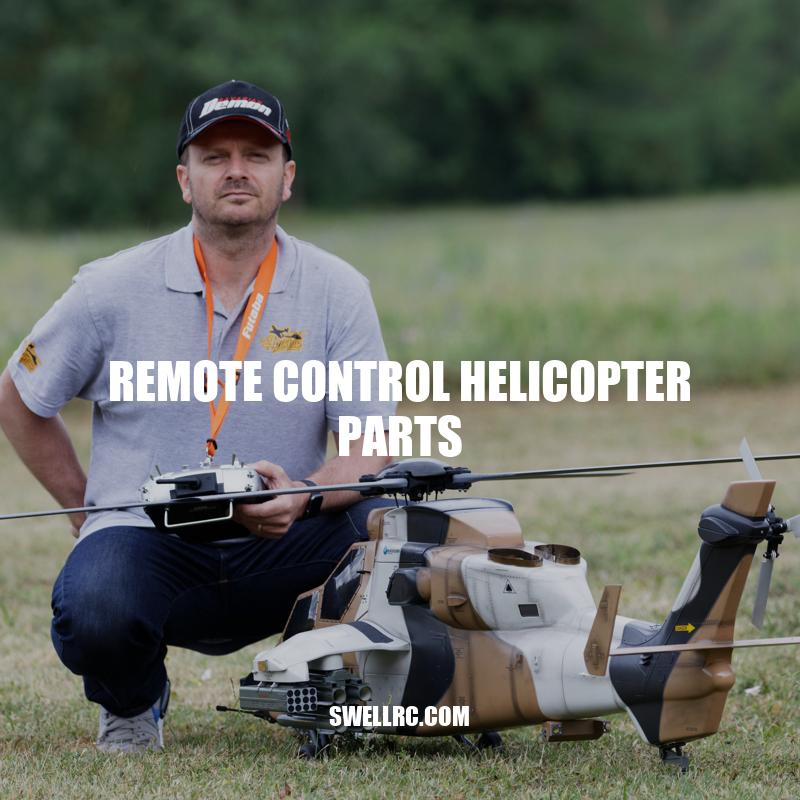Essential Remote Control Helicopter Parts: A Guide to Upkeep and Upgrades.
Remote control helicopters have become increasingly popular over the years, providing individuals with a thrilling and engaging way to fly a miniature aircraft. With the technological advancements available, remote control helicopters are becoming faster, more agile and most importantly, more reliable. However, like any other machine, these helicopters require proper maintenance to ensure consistently high levels of performance. One essential aspect of maintaining a remote control helicopter is to upgrade and replace parts when needed. This article explores the vital parts that make up a remote control helicopter and how each of these parts contributes to the helicopter’s flying capabilities. In addition, the article explains the basic terminology associated with each part, materials used in making these parts, and factors to consider when choosing the most suitable replacement parts for upgraded performance. So, whether you are an experienced remote control helicopter pilot or just starting, understanding the essential parts and how they function is crucial for you to take your flying capabilities to the next level.
Essential Parts of a Remote Control Helicopter
When flying a remote control helicopter, you should have a great grasp of the functions of each of the essential parts. These parts include:
- Main rotor blades: They create lift and help the helicopter to fly
- Tail rotor blades: They provide directional stability and control the torque produced by the main rotor blades.
- Motor: It powers the main rotor blades
- Electronic speed controller: It regulates the speed of the motor
- Servos: They turn the rotor blades and help to control the helicopter’s movements
- Gyroscope: It enhances the stability of the helicopter by working together with the servos
- Battery: It powers the motor and other critical components
Each of these parts plays a critical role in the performance of the remote control helicopter. As such, it is important to carry out regular inspections and maintenance of the parts to ensure that the helicopter remains in good condition.
If you want to buy parts for your helicopter, some credible websites to visit are HorizonHobby.com, Heliguy.com, and Amazon.com.
What do you use to control a helicopter?
- A joystick
- Two control sticks
- Foot pedals
- A control panel
If you are interested in learning more about controlling helicopters or want to purchase equipment for your own use, websites such as Heliguy and UAV Systems International offer a range of products and resources.
Main Rotor Blades
The primary function of the main rotor blades is to create lift and make the helicopter fly. Here are some important points to note about these blades:
| Types of Main Rotor Blades | Materials Used for Main Rotor Blades |
|---|---|
| Symmetrical | Carbon Fiber |
| Asymmetrical | Plastic |
| Semi-Symmetrical | Wood |
Types of Main Rotor Blades
There are three types of main rotor blades: symmetrical, asymmetrical, and semi-symmetrical. Symmetrical blades have uniform profiles on both the top and bottom halves of the blade. Asymmetrical blades, on the other hand, are specifically designed for helicopters to have different profiles on the top and bottom halves. Semi-symmetrical blades have profiles that lie somewhere between the other two types.
Materials Used for Main Rotor Blades
Main rotor blades are made from different materials like carbon fiber, plastic, and wood, among others. Carbon fiber is a preferred material because it is strong, stiff, and lightweight. Plastic blades, on the other hand, can handle impacts better than carbon fiber blades. Wooden rotor blades are durable and require regular maintenance to preserve their functionality.
One interesting fact to note is that the main rotor blades’ size affects the helicopter’s overall lifting ability. Smaller rotors generate less lift, while more massive rotors can lift heavier loads.
If you need to replace or upgrade your main rotor blades, check out websites like AMain Hobbies or Heliguy for a wide selection of high-quality blades. Always refer to the manufacturer’s recommendations before making any changes to your helicopter’s parts.
What does the main rotor blade do?
The main rotor blade is an essential component of a helicopter’s rotor system that provides support and lift. Here are some of its important functions:
- Creates lift: The rotor blade’s airfoil shape generates lift as it rotates, much like the wings of an airplane.
- Controls direction: The pitch of the rotor blades can be adjusted to control the direction of the helicopter.
- Regulates altitude: By adjusting the collective pitch of all the blades simultaneously, the pilot can increase or decrease the helicopter’s altitude quickly.
- Stabilizes flight: The rotor blades also help stabilize the helicopter by counteracting the torque that develops due to the engine’s rotation.
To learn more about the function of main rotor blades, visit helicopter-related websites such as rotorandwing.com or the rotorcraft section of the aviationweek.com website. You can also check out products like helicopter simulators to experience flying a helicopter firsthand.
Tail Rotor Blades
The tail rotor blades are responsible for providing the anti-torque force that prevents the helicopter from spinning on its own axis. Some essential points to understand about these blades are:
| Type of Tail Rotor Blades | Size and Pitch of Tail Rotor Blades |
|---|---|
| Symmetrical | Small and High-Pitched |
| Asymmetrical | Large and Low-Pitched |
Types of Tail Rotor Blades
The two types of tail rotor blades are symmetrical and asymmetrical. Symmetrical blades have a uniform profile, while asymmetrical blades have different profiles on both halves of the blade.
Size and Pitch of Tail Rotor Blades
The size and pitch of the tail rotor blade can have a significant impact on the helicopter’s stability and maneuverability. Smaller blades with high pitch generate less power but are more responsive, while larger blades with low pitch generate more power but are less responsive. Finding the balance between power and responsiveness is crucial when choosing a set of tail rotor blades.
If you need to upgrade or replace your tail rotor blades, you can check out websites like Horizon Hobby or HeliDirect for a wide range of options. Remember always to choose blades that match your helicopter’s specifications and to follow the manufacturer’s recommendations for maintenance and installation.
What is the function of the tail rotor blade?
The tail rotor blade is a critical part of a helicopter’s design, and it plays a key role in maintaining stability and steering the aircraft. Specifically, the tail rotor blade:
- Compensates for the torque generated by the main rotor blades, which can make the helicopter spin in the opposite direction of the blades
- Allows the pilot to control the yaw of the aircraft (i.e. rotate it left or right)
- Is typically mounted at the end of a long tail boom to maximize its effectiveness and distance from the main rotor blades
For more information about helicopter design and operation, check out aviation-focused websites like Aviation Week or products like Microsoft Flight Simulator.
Motor and Electronic Speed Controller
The motor and electronic speed controller work together to control the rotation and power of the main rotor blades. Here are some crucial points to know about these parts:
Types of Motor
There are two types of motor available for remote control helicopters:
- Brushed
- Brushless
Matching Motor and Electronic Speed Controller
To ensure optimum performance, it’s important to match the motor and electronic speed controller based on the helicopter’s specifications. Here are some factors to consider when choosing a motor and electronic speed controller:
- Voltage
- Amps
- Motor and ESC ratings
- Weight
Choosing a Motor and Electronic Speed Controller
If you need to upgrade or replace your motor and electronic speed controller, you can check out websites like Tower Hobbies, AMain Hobbies or Amazon for various options. However, it’s essential to choose a motor and electronic speed controller that match your helicopter’s specifications and follow the manufacturer’s recommendations for maintenance and installation.
How do I choose a motor speed controller?
When looking for a motor speed controller, you need to consider the following things:
- Motor type and specifications: Make sure the controller is appropriate for your motor type and its specifications such as voltage, current and power rating.
- Control method: Determine how you want to control the motor speed – manually or remotely.
- Speed range: Check the speed range of the controller and make sure it covers the range you need.
- Efficiency and heat dissipation: Look for a controller that is energy efficient and has good heat dissipation capabilities.
- Price and warranty: Compare prices and look for a controller that provides a warranty and meets your budget.
There are many websites and products available that offer motor speed controllers, such as Amazon, Banggood, and Sparkfun. Make sure to read reviews and research before making a purchase.
Servos and Gyroscope
Servos and gyroscope are crucial components that help control the movement and stability of the helicopter. Here are some essential points to know about these parts:
Types of Servos
There are two types of servos:
- Analog
- Digital
Installation and Calibration of Servos and Gyroscope
Proper installation and calibration of servos and gyroscope are necessary to ensure your helicopter’s stability and control. You can refer to your helicopter’s manual or manufacturer’s website for specific installation and calibration instructions.
Impact of Servos and Gyroscope on Stability and Control
Here are some ways servos and gyroscope impact the helicopter’s stability and control:
- Servos control the movement of the helicopter’s rotor blades and ensure stability during flight.
- Gyroscope senses slight movements and adjusts the rotor blades accordingly to maintain stability and control.
Choosing Servos and Gyroscope
For replacement or upgrading, you can check out websites like Tower Hobbies, AMain Hobbies or Amazon for various servo and gyroscope options. However, it’s essential to choose servos and gyroscope that match your helicopter’s specifications and follow the manufacturer’s recommendations for maintenance and installation.
Why does a helicopter need a gyroscope?
A gyroscope is a crucial component in a helicopter’s instrument panel. It helps the helicopter maintain stability and orientation in the air. Here are some reasons why a helicopter needs a gyroscope:
- To maintain balance and stability during flight.
- To measure and control the helicopter’s attitude and direction of movement.
- To provide the pilot with important flight data, such as altitude and speed.
Several types of gyroscopes are used in helicopters, including attitude indicators, heading indicators, and turn coordinators. Without a gyroscope, a helicopter would be much more difficult to fly and control.
If you want to learn more about helicopters and their components, you can visit websites like HelicopterEducation.com or AviationPros.com. These websites offer in-depth information on helicopter technology and pilot training.
Battery
Another important component of a remote control helicopter is the battery. Here are some essential points to know about batteries:
Types of Battery
Two main types of battery are commonly used in remote control helicopters:
- NiMH (Nickel-Metal Hydride)
- LiPo (Lithium Polymer)
Proper Use and Storage of Battery
Here are some tips to ensure the proper use and storage of your helicopter’s battery:
- Charge the battery fully before using it.
- Avoid overcharging or undercharging the battery, as it can damage the battery and affect its life.
- Avoid exposing the battery to high temperatures or direct sunlight.
- Store the battery in a cool, dry place when not in use.
- Dispose of the battery safely and properly when it reaches the end of its life.
Choosing a Battery
When selecting a battery for your remote control helicopter, consider the following factors:
- Voltage and capacity
- Size and weight
- Compatibility with your helicopter’s motor and electronic speed controller
You can check out websites like Horizon Hobby, RC Planet or eBay for various battery options. However, it’s recommended to choose a battery that matches your helicopter’s specifications and follow the manufacturer’s recommendations for maintenance and replacement.
Which is the best battery for remote control?
When it comes to choosing the best battery for remote control, consider the following options:
- Alkaline batteries – they are readily available and affordable
- Lithium batteries – they last longer than alkaline batteries and are ideal for high-drain devices
- Nickel-metal hydride (NiMH) batteries – they are rechargeable, eco-friendly and cost-effective in the long run
It’s important to check the remote control manual to see which type of battery is recommended.
If you’re looking for specific product recommendations, check out reputable electronics websites such as CNET or Wirecutter for expert reviews and comparisons.
Conclusion
In conclusion, understanding the different parts of a remote control helicopter is crucial for its maintenance and longevity. Each component has its function, and if any of them is not in good condition, it can negatively affect the performance of the helicopter. Upgrading and replacing parts is necessary to keep the helicopter running smoothly and to ensure its safety.
Knowing the types of parts, their functions, and compatibility with other parts is an excellent way to choose the appropriate components for your helicopter. Always follow the manufacturer’s instructions for maintenance and repairs, and seek professional help if necessary.
Furthermore, there are various websites and stores available online where you can buy parts or kits to assemble your helicopter. It’s crucial to review the specifications and compatibility of each part you are going to purchase.
In summary, maintaining your remote control helicopter and upgrading its parts when necessary is vital for enjoying its full potential. With the proper knowledge and following the manufacturer’s instructions, you can keep your helicopter in top condition for longer.



